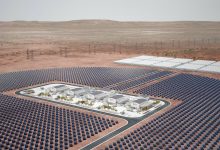Adding battery storage to a 70MW solar plant planned for development near Port Augusta in South Australia would more or less triple the annual revenue of the project, a new report has shown.
The Aurora Project is being planned for construction by South Australia technology company 1414 Degrees after the project was abandoned by US outfit SolarReserve, along with that company’s plans for a 150MW concentrated Solar Tower Project.
1414 Degrees bought the undeveloped project from SolarReserve in late 2019 with the aim of installing a mix of solar PV, battery storage and the ASX-listed company’s unique thermal energy storage system, also known as TESS.
The company said this month it was “pioneering this competitive solution” for the resuscitated Aurora project under the leadership of Marie Pavlik, who was had commissioned modelling from specialist agencies CQ Energy and ITP Renewables and was teaming with energy retailers to bid on power purchase agreements (PPAs).
According to the modelling – a simulation based on the past five years of NEM and FCAS trading – the addition of a 70MWh battery energy storage system to the 70MW plant would generate annual revenues ranging from $44-$80 million, compared to $12.5-$28 million without batteries.
“Although based on historical data that may or may not be a guide to future conditions, these revenue simulations are very encouraging for the development of our Aurora Project,” said 1414 Degrees executive chairman Dr Kevin Moriarty.
“We are working to lock in PPA’s to secure cash flows for the first stage of PV generation to complement the BESS revenue streams.”
The report says a NEM connected solar PV farm with both a BESS (battery energy storage system) and 1414 Degrees’ TESS (thermal energy storage system) will likely fare even better, attracting revenues across wholesale energy, frequency control and ancillary services (FCAS) markets. Modelling on this scenario is in the works.
1414 Degrees’ TESS – the company’s name comes from the very high melting point of silicon, 1414° Celsius – stores energy generated from electricity or gas and supplies both heat and electricity. The energy from the latent heat is recovered as very hot air that powers a turbine to produce heat and electricity when required.
Its plans include using South Australia’s abandoned Aurora Solar Tower Project as a site to pilot its TESS-GRID technology, which the company says could deliver long-duration renewable energy storage services of a similar scale as the dumped concentrated solar project, and on par with pumped hydro.
But those plans hit a major bump in the road last month, after the results of a review of the company’s silicon-based technology found it falling short on key efficiency and reliability metrics, sending the South Australia-based company’s share price down by nearly 40%.
(Just last week, 1414 Degrees’ share price rebounded, jumping from $0.087 on July 15 to a high of $0.22 on July 16, and prompting a “please explain” from the ASX.)
But Moriarty was undaunted by the findings of the review, however, and told RE that the company’s “now highly qualified technical team” was working on fixing the technology’s shortcomings and had mapped out a path to make it competitive in the long-duration energy storage market.
In a statement on July 9, Moriarty said that the addition of the 1414 Degrees’ TESS to the Aurora project would “provide a complete green hybrid solution” for the South Australia grid as renewable penetration increased.
“The Aurora Project can provide robust system strength throughout the NEM because it is situated on major transmission lines, generating revenue stacks from many different services,” he said.










